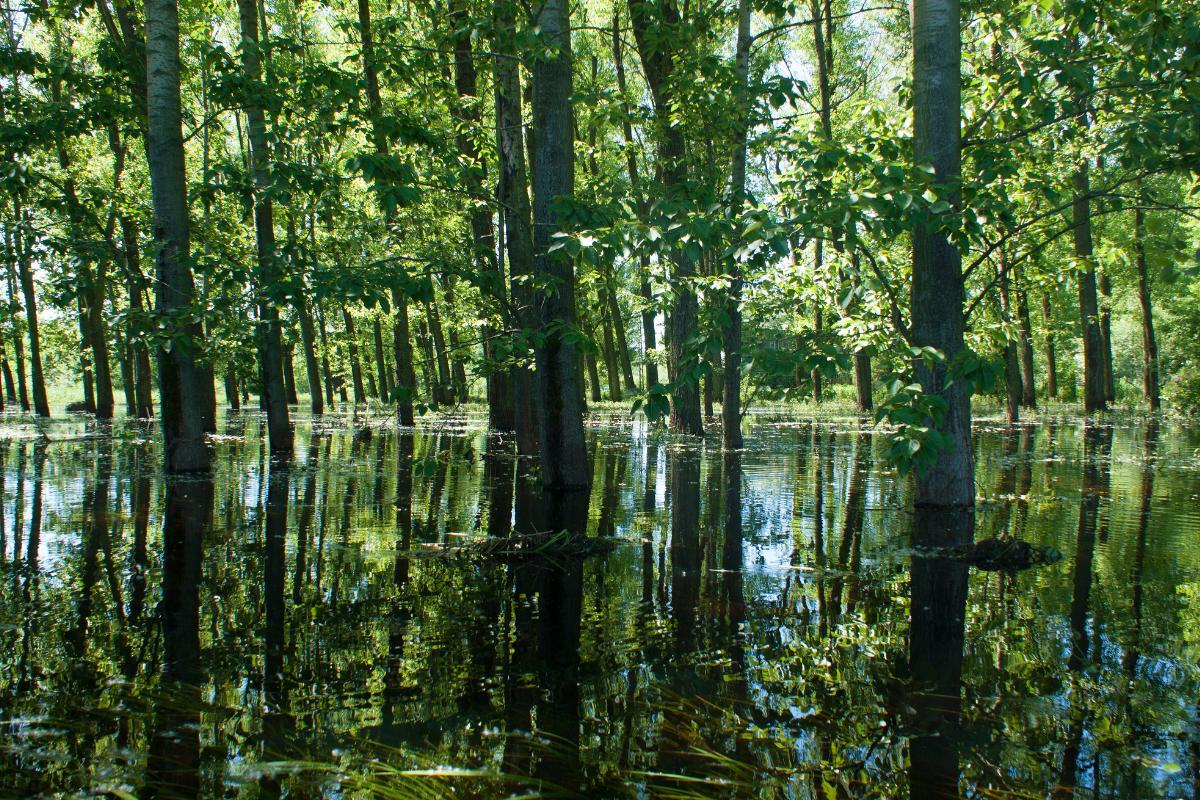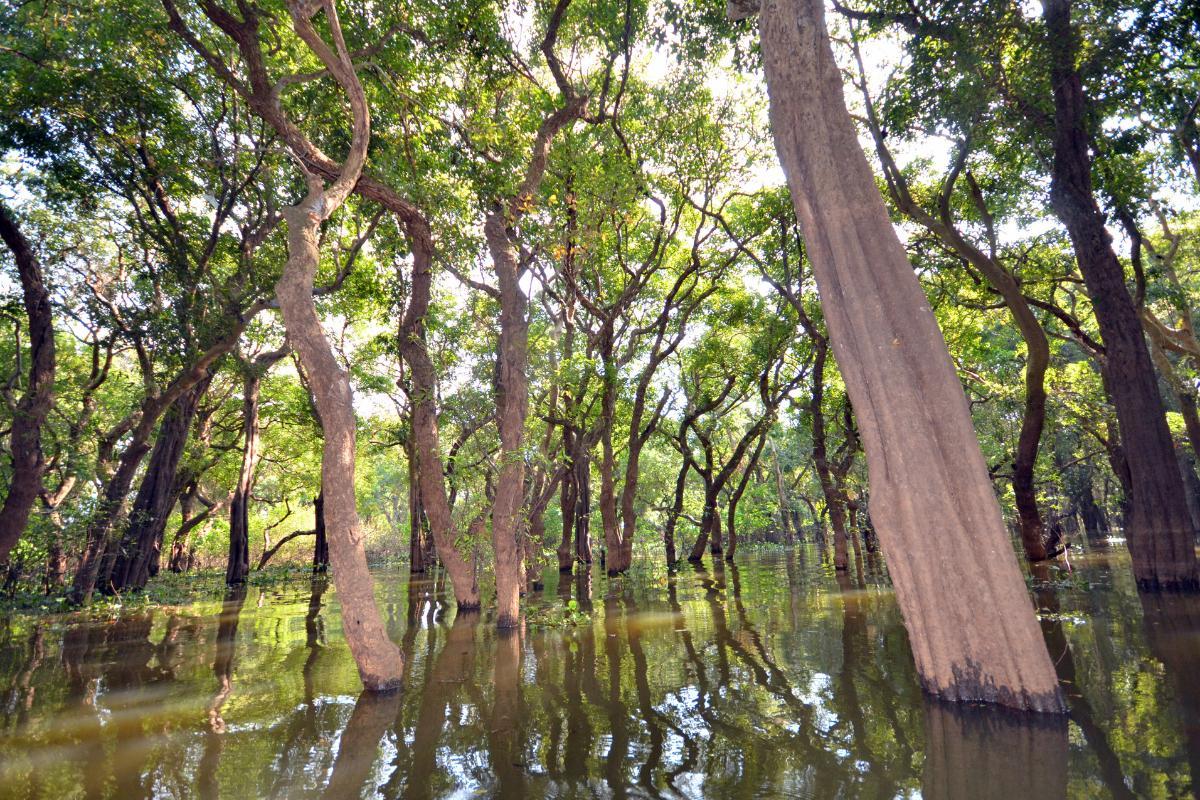What Is a Swamp Forest?


Also known as flooded forests, freshwater swamp forests are characterized by periodic flood by bodies of water such as rivers or lakes. While this flooding can be seasonal, it can be more frequent in certain areas. Their duration and the depth of the flooding can also vary according to region and the specific forest. Due to frequent flooding, the plants and animals of freshwater swamp forests need to be specially adapted to survive there. At thedailyECO, we ask what is a swamp forest? We look in more detail at the characteristics and types of flooded forests, as well as examples from around the world.
What are freshwater swamp forests?
Swamp forests are types of forest ecosystems which remain partially covered by water for part of the year. This is due to seasonal flooding by nearby rivers or lakes. Freshwater swamp forests are known as flooded forests, but it is important to differentiate them from saltwater forests. Trees or shrubs which can survive in saline waters are known as mangroves, so a saltwater swamp forest is known as a mangrove forest.
Flooded forests are typically found in tropical and subtropical regions where periodic abundant rainfall can cause flooding. They are common in areas such as the Amazon and the Pantanal in South America, as well as humid regions in Africa and Asia.
Among the most important characteristics of freshwater swamp forests we can find the following:
- Variable hydrology: the most distinctive feature of these forests is their annual flooding cycle. During the rainy season, water can cover large areas of land. Conversely, water levels drop during dry periods, allowing the soil to partially dry out. Discover more about how this is studied with our article asking what is hydrology?
- Adapted vegetation: plants that live in these ecosystems have developed special adaptations to survive flooded conditions. Many species have aerial roots or structures that allow them to breathe even when the soil is submerged.
- Unique biodiversity: flooded forests are home to a rich biodiversity, both in terms of flora and fauna. They are populated by both aquatic and terrestrial species that take advantage of the seasonal dynamics of these ecosystems.
- Ecological importance: these forests perform vital ecological functions, such as regulating the water cycle, capturing carbon and protecting against extreme flooding of neighboring areas.
Discover the different types of ecosystems with our related guide.

Types of swamp forests
While all swamp forests will have the characteristics described above, they can also vary significantly between each other. This is due to aspects of their terrain, type of water or other factors. We see the types of flooded forests below:
- Várzea forests: these forests are found on the floodplains of large rivers, such as the Amazon. They are seasonally flooded by rivers overflowing due to rainfall. The flooding in várzea forests is by whitewater and generally rich in nutrients, contributing to high biological diversity and fertile soils. Inhabitants of these areas often build floating homes to deal with the flooding.
- Igapó forests: similar to várzea forests, igapó forests are flooded by blackwater instead of whitewater. Blackwater is found in slow-moving channels through forested areas. It is generally lower in nutrients than whitewater and has a higher acidity, but its flora and fauna have adapted accordingly.
- Freshwater swamps: also known as freshwater wetlands, these flooded forests are found in areas where flooding is caused by heavy rains or the overflow of lakes and lagoons. They are common in tropical and subtropical areas, such as the Pantanal which is one of the largest wetlands in the world. These ecosystems are home to rich biodiversity and play an important role in regulating the water cycle.
- Marsh forests: these forests grow on water-saturated soils, although they do not necessarily experience deep flooding. They are found mainly in temperate regions and are important as aquifer recharge areas and natural water filters. Discover the different types of aquifers in our related guide.
- Riparian forests: those that develop along the banks of rivers and streams in areas that experience temporary flooding. They can be found in various climatic regions and their ecosystems are essential to prevent bank erosion, as well as for maintaining water quality.
- Mangrove forests: as we have explained, mangroves are trees adapted to living in saline waters. These flooded saltwater forests are found in tropical and subtropical coastal areas where this specially adapted vegetation thrives. Mangroves are subject to the influence of tides, so flooding occurs daily. These forests protect the coasts from erosion and act as refuges for various marine species.
Mangroves are the type of plant which can handle water with high salinity, but this term is also used to refer to the saltwater swamp forests themselves. Discover more about how certain plants make up these saltwater ecosystems with our article asking what are mangroves and why are they important?

Examples of swamp forests
As we have stated, swamp forests tend to be located in tropical or subtropical regions with heavy rainfall. This means they are not present in all of the world's ecoregions. We look at some examples of swamp forests from around the world according to the ecoregion in which they are present:
Australasia
In the Australasian region, swamp forests are present in countries such as Australia, Papua New Guinea and the Pacific Islands. One of the most representative ecosystems are the mangroves of northern Australia, especially in the Queensland region. These coastal forests are regularly flooded with brackish water during tides. This is essential for protecting coasts from erosion and for maintaining habitats for fish, crabs and birds.
In Papua New Guinea, there are extensive freshwater swamp forests. These are seasonally flooded due to tropical rains, providing refuge for various endemic species.
South and Southeast Asia
The Sundarbans is the coastal region between India and Bangladesh. It is one of the most iconic swamp forests in the world. This vast mangrove forest is the largest in the world and is regularly flooded due to the tidal influence of the Bay of Bengal. The Sundarbans is known for being the home of the famous Bengal tiger, as well as providing habitats for a wide variety of aquatic and terrestrial species.
In Southeast Asia, mangrove forests in Indonesia, Vietnam and the Philippines also stand out. They play an essential role in protecting coastlines and marine life. Similarly, there is the Tonlé Sap lake in Cambodia, a flooded forest ecosystem that experiences a large fluctuation in water levels during the rainy season. It is one of the richest places in biodiversity in the region and in the world.
Neotropics
The Neotropical region is rich in flooded forests, with the Amazon being the most iconic example. Within this vast region, várzea and igapó forests are the most prominent. Várzea forests are seasonally flooded with nutrient-laden freshwater from overflowing rivers, such as those in the Amazon basin in Brazil and Peru. In contrast, igapó forests are found along blackwater rivers such as the Rio Negro. They have nutrient-poor soils and experience prolonged flooding.
Tropical Africa
In tropical Africa, flooded forests are found in several major river basins such as the Congo Basin. The swamp forests along the Congo River and its tributaries experience seasonal flooding and are home to unique species such as lowland gorillas, forest elephants and a wide variety of birds and fish.
The mangroves of the Niger Delta in Nigeria are also a notable example of flooded forests. These mangroves are located in the coastal zone and are flooded due to the mixing of fresh and salt water at the mouth of the Niger River. These ecosystems are essential for local fisheries and serve as natural barriers against storms and coastal erosion.
While we have seen examples of both mangrove and freshwater swamp forests, it is the freshwater swamp forest which is more common across the world. These areas are more abundant and widespread. However, both are essential for various global communities and for their various ecosystems. Since deltas form at the mouths of rivers, they are often communicating areas between different types of swamp forest.
Learn more about what is a delta and how is it formed with our related guide.

If you want to read similar articles to What Is a Swamp Forest?, we recommend you visit our Ecosystems category.
- Amazonian flooded forests, crucial for aquatic biodiversity. Amazonian Waters. https://aguasamazonicas.org/humedales/tipos-de-humedales/bosques-inundables
- ECOLOGY EXHIBITION Flooded and Floodable Forests. SCRIBD. https://es.scribd.com/document/516494717/EXPOSICION-ECOLOGIA-bosques-inundados-e-inundables








